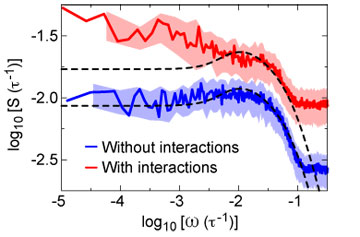Fluctuating ionic currents through nanopores
The scale of ionic nanopore transport implies a high noise level compared with the signal strength.
Also the noise, however, contains a wealth of information on the molecular details of the transport process.
Measuring the ionic current passing through a nanometer-scale membrane pore has emerged over the past decades as a versatile technique to study molecular transport. These measurements, however, suffer from high noise levels, which typically exhibit a power law dependence on the frequency. A thorough theoretical understanding of the power spectrum is essential for the optimization of experimental setups and for the use of measurement noise as a novel probe of the nanopore's microscopic properties.
We calculate the power spectrum of electric-field-driven ion transport through nanopores using both linearized mean-field theory and Langevin dynamics simulations [1,2]. With only one fitting parameter, the linearized mean-field theory accurately captures the dependence of the simulated power spectrum on the pore radius and the applied electric field. Remarkably, the linearized mean-field theory predicts a plateau in the power spectrum at low frequency f, which is confirmed by the simulations at low ion concentration (Fig. 1). At high ion concentration, however, the power spectrum follows a power law that is reminiscent of the 1/f dependence found experimentally at low frequency. Based on simulations with and without ion-ion interactions, we attribute the low-frequency power law dependence to ion-ion correlations.

Measuring the ionic current passing through a nanometer-scale membrane pore has emerged over the past decades as a versatile technique to study molecular transport. These measurements, however, suffer from high noise levels, which typically exhibit a power law dependence on the frequency. A thorough theoretical understanding of the power spectrum is essential for the optimization of experimental setups and for the use of measurement noise as a novel probe of the nanopore's microscopic properties.
We calculate the power spectrum of electric-field-driven ion transport through nanopores using both linearized mean-field theory and Langevin dynamics simulations [1,2]. With only one fitting parameter, the linearized mean-field theory accurately captures the dependence of the simulated power spectrum on the pore radius and the applied electric field. Remarkably, the linearized mean-field theory predicts a plateau in the power spectrum at low frequency f, which is confirmed by the simulations at low ion concentration (Fig. 1). At high ion concentration, however, the power spectrum follows a power law that is reminiscent of the 1/f dependence found experimentally at low frequency. Based on simulations with and without ion-ion interactions, we attribute the low-frequency power law dependence to ion-ion correlations.

Fig. 1. The power spectral density with the ion-ion interaction
potential consisting of Lennard-Jones and Coulomb interactions (red
line), and with the ion-ion interaction potential turned off (blue
line).
The spectrum is calculated in a 2.5-nm radius channel with a
longitudinally applied electric field of 8 kBT/(e nm).
| [1] | M. Zorkot, R. Golestanian and D. J. Bonthuis; The power spectrum of ionic nanopore currents: The role of ion correlations; Nano Lett. 16, 2205 (2016). | |
| [2] | M. Zorkot, R. Golestanian and D. J. Bonthuis; Current fluctuations in nanopores: the effects of electrostatic and hydrodynamic interactions; Eur. Phys. J. Special Topics 225, 1583 (2016). | |